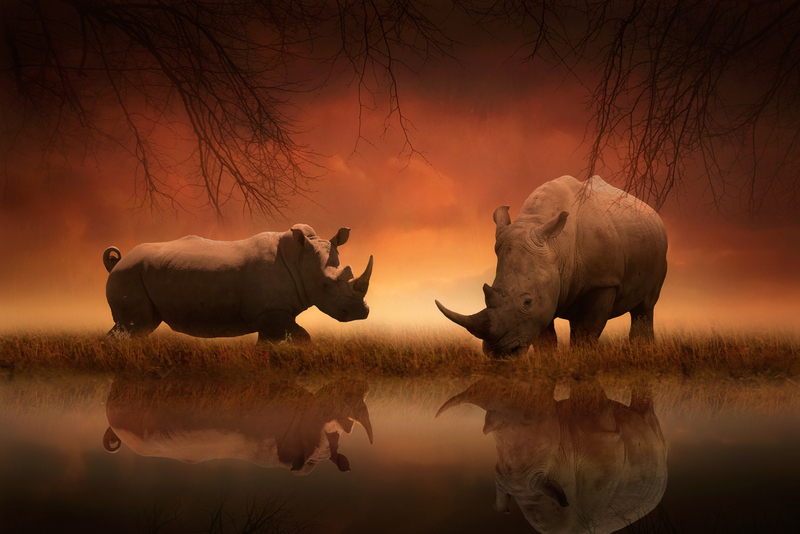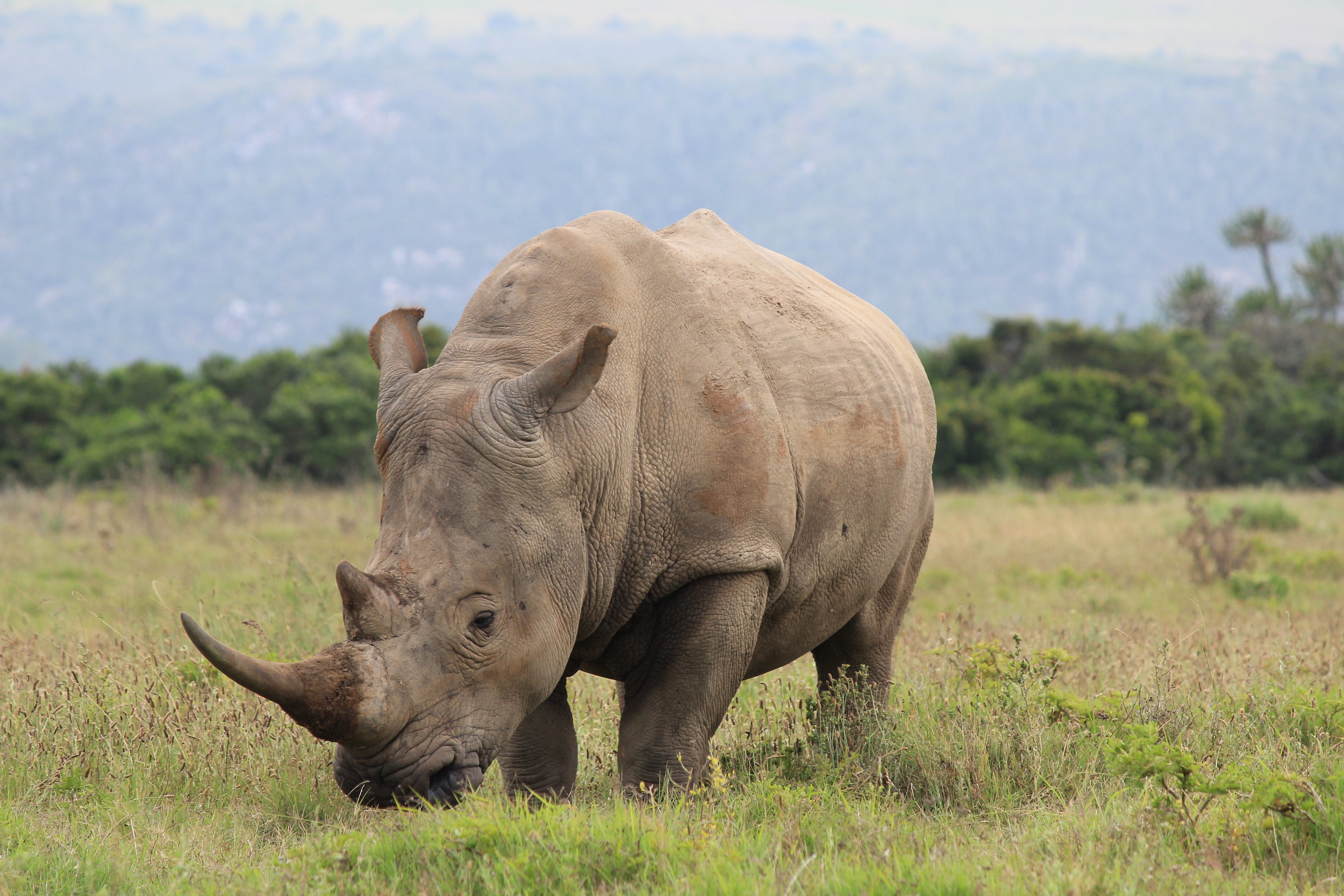Thandi's Story - Part I - Kariega Game Reserve
This story is about the poaching of three rhinos at Kariega, but it is also a story about the people on the ground and their involvement in the treatment of these animals and their part in the desperate fight against poaching. The story has been broken up into four parts which we will be sharing with you over the next few days.
It is important to take this opportunity to thank all those on the ground who were by Thandi and Themba's side, those who sent us messages of support and contributions toward their recovery, and those who have followed and helped spread the inspiring story of Thandi - creating a global awareness on rhino poaching in southern Africa.
Thank you to local journalist, Lauren Daisy Flynn, for sharing this story with us.
Forward
I started writing ‘Courage in the loss of Hope’ in September 2013. I was in my final year at Rhodes University completing my Bachelor in Journalism when I decided to write a long form journalism piece on the rhino poaching epidemic.
I wrote about Thandi and Themba’s journey leading up to and after the poaching incident on 2 March 2012. Living in the Eastern Cape at the time, Kariega’s news hit close to home for me, so I wanted to tell the story not only about the rhinos but also about the people on the ground affected on a daily basis by poachers’ greed.
The month I finished writing the story the total poaching number had reached 618. The day this story was published by Kariega Game Reserve it reached 919. I hope Thandi’s story will continue to touch people and raise awareness to help stop rhino poaching once and for all.
Below a digital artistic tribute to Thandi and Themba by Jennifer Woodward.

Courage in the loss of hope
Part I
By Lauren Daisy Flynn
They say that the cry of a wounded rhino never leaves you, and that those who have heard it would not wish it upon their worst enemy. They say it is a plaintive, moaning cry that cuts deep into your soul. It is the sound you hear when a rhino wakes with half its face and struggles to its feet, dazed and confused, into a fate it will never understand.
On Friday 2 March 2012 this sound echoed through the valleys on Kariega Game Reserve in the Eastern Cape. During the night three rhinos were darted and mutilated. When the sun rose, two were making that ghastly cry. In an insane way, this was to become normal; before the year was over, nearly seven hundred of their diminishing species would be butchered for their horns. But this isn’t just another poaching story. All three rhino should have died, but one didn't.
One survived to begin a new era in rhino poaching awareness and veterinary science across the globe.
*****
She was a normal rhino. She didn’t have a particularly distinctive feature about her. She had a calm and quiet nature. No one would have necessarily picked her out of her crash of five for any particular reason. She was just another female rhino at Kariega. But in the early hours of that late summer night she became known as the rhino who survived. She became Thandi (pictured below before poaching).
The rangers confidently speculate that it happened in the dead of night. There were no sounds. No warning signs. No one knew it was happening. Everyone, even the rhinos, were asleep.
This family of five – Bull 84, Themba, Thandi, Mum and Calf – would usually sleep together. They had started moving and living together since the poaching at Kariega in 2010. Three rhinos had been lost already. It was as if they understood the threat, and sought strength in numbers. But that last night was peculiar.
Mum and Calf had wandered off in the afternoon, unintentionally separating themselves from the crash. The others searched for them throughout the day, trying to reunite before dark, but it was not to be. Like a merry-go-round they circled their route missing each other every time. Eventually at sunset, Mum and Calf retreated down the valley whilst Thandi, Themba and Bull 84 returned to their usual spot and retired for the night.
Humans for decades have philosophically and rationally debated whether animals demonstrate basic cognitive aspects or if they can feel emotions like humans do. Ethics illustrate very different subjective pictures of the relationship between the animal kingdom and the human species. These ethics have continuously plagued academics and the common person on a day-to-day basis with no unanimous resolution ever in sight. However, a common thought throughout this ageless debate is the existence of a sixth sense. Animals have been believed to possess a sixth sense that humans cannot fully comprehend or copy. It enables them to sense abnormalities, dangers and demonstrate logical emotions. Whatever the truth may be or the position you may hold, a mother rhino saved her baby calf that night.
The rest of the family were not as lucky.
Bang. Bull 84 was hit as he slept. Themba and Thandi shot up and ran. Confused. Startled. Curious, with weak vision, they ran together in a circle around the poachers to pick up their smell in the wind. Bang. Themba was hit. He stumbled as he descended into a deep sleep. Thandi jolted. Alarmed. Nervous. Inquisitive, she ran another circle in another attempt to pick up the scent to understand what was happening to her family. Bang. She was down.
One of the typical choices of weapon for a poacher, especially in the Eastern Cape, is a dart gun filled with etorphine or thiafentanil. These are generic veterinary drugs commonly used in the field to anesthetise the animals being worked on by wildlife vets. It is not known for sure whether these are the drugs being utilised, but vets suspect the poachers are purchasing them off the black market. Unfortunately, the poaching trade is a very lucrative industry meaning they have easy access to resources illegally.
A dart gun is subtle and silent. A rifle gun is conspicuous and loud. A dart can hit any part on the animal’s body to successfully bring the animal down into a quick slumber, whereas a bullet is only lethal if it hits the brain or a vital organ. The dart has the greater success rate and the slowest death. Thandi, Themba and Bull 84 were immobilised by doses of etorphine or thiafentanil while the poachers hacked at their horns.
Some people believe a rhino under anaesthetic does not feel its horn being removed. It’s said to be a painless extraction by the poachers. This is far from the truth. More often than not it is suspected that the animals experience an under dose of drugs meaning they are conscious while their horns are being sawed, axed or dug out. If the amateur manages to administer a correct dosage according to the individual rhino, which is incredibly rare, it wakes up into an inconceivable pain as the drug wears off.
An overdose of the drug can be lethal to the animal as the drug shuts down their respiratory system and it slips away – if it’s lucky enough. Otherwise, if the dose is not strong enough, it bleeds out while being fully conscious, aware and dumb. It can die from shock and a loss of blood pressure leading to cardio failure. The poachers cut the horn off slicing into the flesh, skin and skull below missing any vital organs sentencing the animal to a slow, excruciating death.
Bull 84 died of an overdose. He died while immobilised and bled out.
A ranger stumbled upon Bull 84 the following morning on his way to work. Routine kicked in. He called Shaun.
*****
“I’ve found a bull. He’s been poached. I think he is dead.”
The two most dreaded words. Poached. Dead. The monosyllabic words loaded with so much pain and hopelessness. The words struck Shaun down unaware. Cold goosebumps rushed over him. Emotions paralysed him as he instinctively switched into protocol.
The 29-year-old game ranger has been working in Kariega Game Reserve since 2008, a couple of years later in 2010 the first rhino was taken from the reserve. When Shaun Patrick Giles began his profession he always knew about the demand in rhino horn for the Chinese Traditional Medicine market and the ever-present ivory trade, however, this reality he never imagined.
Between 2010 and 2011 three rhinos were taken under his watch as a field guide. He lost one dear to him. Her name was Broken Horn. Together they shared a unique bond – a relationship of trust. She was killed on 5 January 2011.
She would hear Shaun’s voice from the game ranging vehicle and promptly appear out of the thicket as if on cue. It was almost as if they had rehearsed a production for the guests. Shaun would introduce Broken Horn, and she would emerge, majestic, beautiful and a little vain as she posed for the guests’ flashing cameras. Once she seemed satisfied in basking in their admiration and excitement she would leave them to her daily business. Shaun was the first ranger to be introduced to her calf. She brought it out for Shaun to see, to reassure him all was fine. Shaun loved Broken Horn. She was the second to be taken from Kariega Game Reserve. She was his first real loss.
She changed Shaun. Their bond was shattered, but her death would not be futile in his mind. He became obsessed. It started eating on him. He felt an overwhelming duty to protect the others.
When he got the call about Bull 84, these unwanted memories rushed back over him. “Please God, not another one, could I have saved this one?”
There was no time for tears. A clear, levelled head was needed. The reserve’s immediate procedure entailed them to mark off the area and close down. They called the people they were required to in a poaching incident. Dr William Fowlds, the Investec Rhino Lifeline and Amakhala vet, was one of the first to arrive immediately on the scene. It was his second poaching at Kariega.
He hoped this time, maybe, he could save them.
*****










